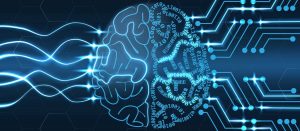NEURAL NETWORKS
What is this? How it works? How to train it and what the future holds for artificial intelligence.
Today the Alexhost.com team will try to give you answers to all these questions. We will try to go deeper and reveal the topic, and of course we will not leave you without attention.

Bаckstory
The history of neural networks goes back as far as the 1940s, when a group of scientific researchers began to study the use of networks of artificial neurons to mimic information processing similar to the human brain.
In the following decades, advances in computer technology and better understanding in neuroscience led to the modern development of more sophisticated neural network models.
One of the most influential early developments in this area was the Perceptron algorithm developed by Frank Rosenblatt in the 1950s. This algorithm showed that simple neural networks can be taught to recognize patterns in data – this is today the principle of the algorithm for the operation of neural networks.
However, despite initial promises, the field of neural networks has been stagnant for several decades due to a lack of development in machine and computing power, and of course, a lack of theoretical knowledge. It wasn’t until the late 1980s that the field saw a resurgence with the development of backpropagation, a powerful learning algorithm that allowed large and complex neural networks to be trained.
Since then, neural networks have become a cornerstone of artificial intelligence and have been used for a wide range of tasks, from image and speech recognition to natural language processing.
To date, the development and training of neural networks is the most sensational and most active area of research and development, new methods and architectures are constantly proposed and tested.
Let’s get acquainted with the neural network.
A neural network is a model of computer perception and subsequent learning based on the structure and function of the actions of the human brain. This model consists of interconnected “neurons” that process data among themselves and transmit further information.
The input to a neural network passes through a series of interconnected nodes, each of which performs a simple calculation. These computations can be thought of as decisions or transformations as well as learning that the data undergoes on its way out. The connections of these nodes are associated with weights, which determine the strength of the influence of one node on another.
The task of training neural networks is to select weights that minimize the error between the network’s predictions and the actual output results as much as possible. This process is known as error backpropagation, which uses gradient descent to adjust the weights and minimize the error.
Neuron and synapse, what is it and what function does it perform?
- The neuron is the basic building block of the nervous system in any animal, as well as in artificial neural networks. In the context of artificial neural networks, a neuron is a data processing unit that receives input from other neurons, also performs calculations and produces outputs that are subsequently passed to other similar neurons for subsequent calculations, this process of reducing errors between network predictions and real outputs. results.
- A synapse is what connects two neurons. In the human brain, synapses transmit signals between neurons by releasing chemicals that bind to receptors on the receiving neuron. In artificial neural networks, the analalag of a synapse is a connection between nodes, which is represented by a weight that determines the strength of the connection.
What are the types of neural networks?
There are several types of neural networks, and each type is designed for specific tasks.
The most commonly used types of neural networks are:
- Feedforward Neural Networks: This is the simplest type of neural network in which data flows in only one direction, from input to output.
- Convolutional Neural Networks (CNN): This is a type of feed-forward neural network that is particularly well suited for image recognition tasks. They use convolutional layers to automatically learn the relevant features.
- Recurrent Neural Networks (RNN): The connections of this neural network form a directed loop that allows information to be stored. Most commonly used for speech recognition and natural language processing.
- Autoencoders: A type of feedforward neural network used for unsupervised learning. The process in this type of network occurs under partial encoding of the input data, and partial decoding of the original data, which recovers from the compressed representation.
- Generative Adversarial Networks (GAN): a type of neural network with two parts: a generator that creates new data samples, and a discriminator that evaluates the samples generated by the generator and also tries to distinguish them from real data. GANs are most commonly used for image synthesis and data augmentation.
These are the most common types of neural networks, but there are others, including deep belief networks, Boltzmann machines, and self-organizing maps.
In what areas are neural networks used?
Neural networks – can be used to solve a huge range of problems:
- Natural Language Processing (NLP): text classification, machine translation and sentiment analysis.
- Recommendation systems: to provide personalized recommendations to users, such as movie or product recommendations, based on their past behavior.
- Anomaly Detection: Can be used to detect outliers or anomalies, such as detecting fraud in financial transactions.
- Predictive Modeling: Can be used to make predictions based on past data such as stock prices or weather conditions.
- Games: Neural networks have been used to develop AI players for games such as chess, go and video games.
These are just a few examples of how neural networks can be used. The versatility of these models means they can be applied to a wide range of applications and industries, from finance and healthcare to transportation and marketing.
Scope of neural networks.
The scope of neural networks is very wide and covers a huge range of industries. Neural networks are used for such tasks:
- like image classification, object detection and image segmentation
- writing and classifying texts,
- voice recognition and sentiment analysis
- to provide personalized recommendations to users, such as movies or products, based on their past behavior
- to detect outliers or anomalies in a dataset, such as detecting fraud in financial transactions
- to forecast based on past data such as stock prices or weather conditions
- to develop AI players for games like chess, go and video games
- for diagnosing diseases, predicting patient outcomes and analyzing medical images.
- for fraud detection, stock price forecasting and financial data analysis.
- to improve traffic flow, predict accidents and optimize vehicle routes.
- to analyze customer behavior, predict sales and personalize advertising.
These are just a few examples of the many areas in which neural networks are applied. The versatility of these models means that they can be used to solve a wide range of problems and optimize various processes in many industries. The scope of neural networks continues to expand with the development of new applications and advances in machine learning.
What servers are used for neural networks and why?
The servers used for neural networks are typically high performance computing systems that provide enough processing power, memory, and storage to be able to train and run large and complex neural networks. The AlexHost.com team recommends using several types of servers, including:
- Server Graphics Processing Units (GPUs): GPUs are specialized hardware accelerators optimized for parallel computing and widely used in machine learning and deep learning applications. GPU servers provide high parallel computing performance and can significantly speed up the training process of large and complex neural networks.
- Central processing unit (CPU) servers: CPU servers are general purpose computing systems that provide enough processing power to train and run neural networks. While they may be slower than GPU servers, they are more versatile and can be used for a wider range of applications.
- Tensor Processing Units (TPU): TPUs are specialized hardware accelerators developed by Google specifically for machine learning and deep learning applications. TPUs provide high parallel computing performance and are designed to work seamlessly with Google’s TensorFlow cloud computing platform.
- Cloud computing platforms. Cloud computing platforms such as Amazon Web Services (AWS), Microsoft Azure, and Google Cloud provide access to a wide range of computing resources that can be used to train and run neural networks. Cloud computing platforms can be cost-effective and scalable, allowing users to quickly provision and remove resources as needed without investing in expensive hardware.
The choice of server for neural networks depends on several factors, including the size and complexity of the network, the size of the training data, and the desired speed and accuracy of the training process. As a general rule, GPU servers are preferred for training large and complex neural networks, while CPU servers and cloud computing platforms are more suitable for smaller, less complex networks or for deployment and inference.
Conclusions
Neural networks (artificial intelligence (AI)) is a rapidly evolving field that aims to develop intelligent machines capable of performing tasks that would normally require human intelligence. In recent years, artificial intelligence has made significant progress.
AI is transforming industries and creating new ones, and can bring significant social and economic benefits.
However, the development and deployment of AI also raise important ethical, legal and social issues such as privacy, accountability, transparency and bias. Ensuring that AI systems are designed and used responsibly, and that they are consistent with human values and goals, is a major challenge facing the AI community.
Also, the development of AI will continue to depend on advances in machine learning, big data, and high performance computing, and will require collaboration between researchers, practitioners, policy makers, and society at large.
P.S
AlexHost.com follows all the latest AI trends and aims to provide the best customer service. For those interested in AI development or who have a need for a GPU server, AlexHost.com offers a dedicated server with high performance GPUs including an Intel® Core™ i7-4770k processor, 16GB RAM, 8GB RX580 GPU and shared port 1 Gbps for only 99 euros per month.
To activate the service, please visit the link for registration of the service: https://bill.alexhost.com/tickets/new/
* Be sure to include a comment on the configuration in the ticket Intel® Core™ i7-4770 ( 4 Cores, 8 Threads ) 16GB RAM, GPU RX580 8 GB – for 99 euro
We are running this service in test mode, so if you have questions, please contact us.
Telegram online chat: https://t.me/alexhost_on
Also, you can always get acquainted with our range of services on our website (alexhost.com).
AlexHost.com – your access to the best VPS hosting services: SSD shared hosting, SSD VDS/VPS servers, dedicated servers, domain names, SSL certificates, shared hosting.


